|
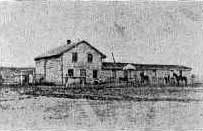
Birth Place
Platte Valley Lodge 32
North Platte, NE - Nov. 15, 1869 |
|
Nov. 15, 1869 in a room 24x24 feet in
size, in the second story of the Charles McDonald store
building, a rough frontier structure more useful than elegant.
$60 was spent on furniture for this modest lodge room and at
the first meeting five Masons were present as their names have
been preserved. Rev. A. A. Reese, army chaplain and
first master of the lodge. |
|
|
|
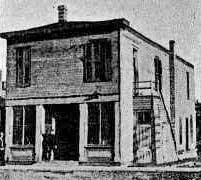
Platte Valley Lodge 32 - 1872 |
|
The modest two story frame building,
long known as the Masonic hall, that occupied the site of the temple
was erected in 1872 at a cost of $2,600. The amount was raised
by the sale of shares at $50 each to local Masons. |
|
|
|
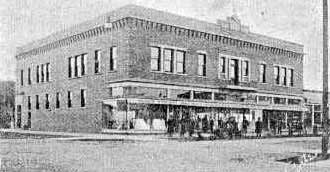
Platte Valley Lodge 32
- Feb. 22, 1908 |
|
Free Mason erected a temple
creditable alike to Masonry and the city at a cost of $30,000.
The Masonic Temple was built towards the close of 1907, and
dedicated Feb. 22, 1908. The ground floor is occupied by
spacious stores, and the second by a banquet hall, reading and
lodge rooms. |
|
|
|

Platte Valley Lodge 32
- June 6, 1987 |
|
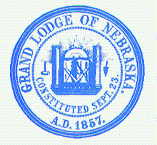
Nebraska State Seal
|
|
|
|
|
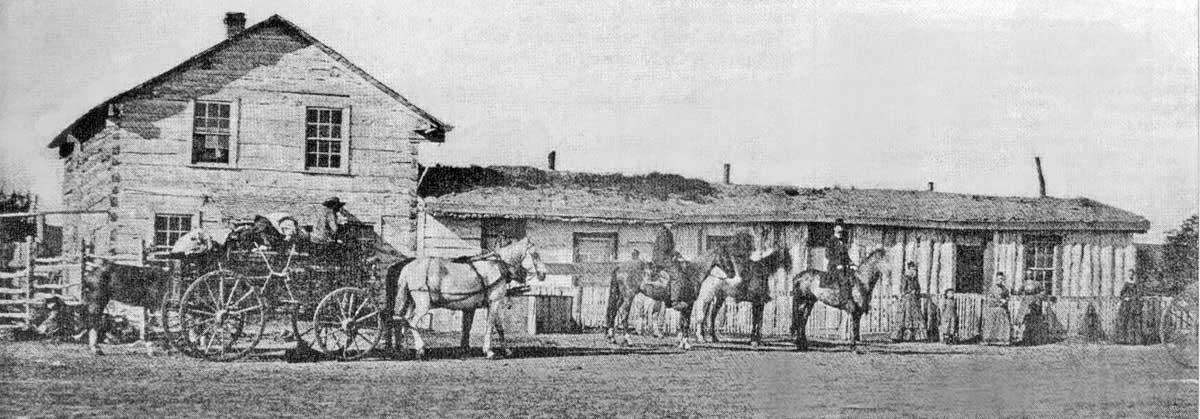
The McDonald
Ranch, located near Cottonwood Springs, south of the Platte River.
McDonald used part of his home to sale merchandise to those traveling
on the Oregon Trail. |
|
|
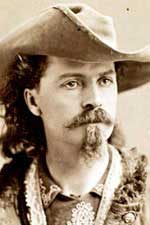
William F. Cody - 1875 |
|
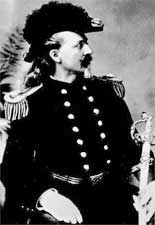 |
|
Cody, "Buffalo Bill" William F. - Indian fighter, Wild
West Show - Platte Valley Lodge No. 32, North Platte, NE.
Cody was active in the concordant bodies of Freemasonry, being
initiated in
Platte Valley Lodge No. 32,
North Platte, Nebraska, on March 5, 1870. He received his 2nd and 3rd
degrees on April 2, 1870, and January 10, 1871, respectively. He
became a Knight Templar in 1889 and received his 32 degree in Scottish
Rite of Freemasonry in 1894.
- Entered Apprentice: March 5, 1870
- Fellowcraft: April 2 1870
- Master Mason: January 10, 1871
|
|
At the age of
40 he petitioned Euphrates Chapter No. 15, Royal Arch Masons,
of North Platte, Nebraska on September 1, 1887. He was
advanced to the Degree of Mark Master, inducted into the
oriental chair and received and acknowledged a Most Excellent
Master on November 14th, 1888. He was exalted to the Royal
Arch Degree on November 15th, 1888 |
|
This "Buffalo Bill" walking cane was purchased from a museum in
London who had acquired it around the turn of the century (1900)
from the man Cody had given the cane to! Buffalo Bill was in
England at the time performing his Wild West Show for Queen
Victoria's Golden Jubilee when this cane somehow was broken. He
took it into a London shop to have it repaired and instead bought
himself a new one, giving the broken one to the man who assisted
him. The man wrote a letter that states the following: "The
attached walking cane was given to me by the famous American
Showman Mr. William "Buffalo Bill" Cody when he visited the shop
James Payne & Sons Ltd. for which I was the Manager in charge in
1892. He purchased a new cane, this one being broken. Mr. Robert
N. Ruffin, London, 26th July, 1910." This cane was originally a
presentation piece from a New York Masonic Lodge as the Square and
Compasses and the initials N.Y. are engraved upon the sterling
silver band on the cane. Buffalo Bill made many visits to N.Y.
Lodges while his Wild West Show was located there.
At the request of Platte Valley Lodge of North Platte, Golden City
Lodge No. 1 conferred Masonic burial rites on June 3, 1917, atop
Lookout Mountain, at 3:00 o'clock in the afternoon. Worshipful
Master G. W. Parfet, Jr. of Golden City Lodge No. 1 appointed
eight Brother pallbearers who were in their full-dress Templar
uniforms. At the request of Mrs. Cody, and almost five months
after his death, the casket was opened and an estimated 10,000
viewed the deceased pioneer and trail blazer. |
|
|
|
| It was
estimated that more than 20,000 persons visited the spot and
15,000 were present at the burial ceremony having walked or ridden
to the top of Lookout Mountain. It was certainly one of the
largest, if not the largest, Masonic burial ever. These words were
said by the Masons over the grave: "His spirit ascends to God who
gave it. His memory we cherish in our hearts. His body we consign
to the earth." |

Platte Valley Lodge 32 Past Masters

|
Masonic Presidents of
the USA
|
- George Washington
- James Monroe
- Andrew Jackson
- James Buchanan
- Andrew Johnson
- James Garfield
- William McKinley
|
- Theodore Roosevelt
- William Taft
- Warren Harding
- Franklin D. Roosevelt
- Harry S Truman
- Lyndon Johnson
- Gerald Ford
|
|
|
Masonic Founding Fathers
of the USA
|
- Benjamin Franklin
- John Hancock
- Joseph Warren
- Paul Revere
- Henry Knox
- John Blair William
|
- John Sullivan
- John Paul Jones
- Mordecai Gist
- Edmund Randolph
- John Marshall
|
|
|
Masonic Military &
Political Leaders of the USA
|
- Gen Henry Harley "Hap"
Arnold
- Gen. Omar Bradley
- Sir Winston Churchill
- Adm. William Crowe
- Gen Geo. Marshall
|
- Gen. Douglas Macarthur
- Gen. Matthew B. Ridgway
- Audie Murphy
- Gen. John Pershing
- Eddie Rickenbacker
|
|
|
Masonic Entrepreneurs
|
- John Jacob Astor
- Walter Chrysler
- John Eberhard Faber
- Henry Ford
- King Gillette
|
- Charles Hilton
- Andrew Mellon
- J. C. Penny
- Nathan Rothschild
- Arthur Godfrey
|
|
|
Famous Freemason Actors
& Directors
|
- James Monroe
- Gene Autry
- Ernest Borgnine
- Eddie Cantor
- Cecil B. DeMille
- Douglas Fairbanks
- W. C. Fields
- Glenn Ford
- Clark Gable
|
- Oliver Hardy
- Harry Houdini
- Al Jolson
- Louis Mayer
- Tom Mix
- Roy Rogers
- "Red" Skelton
- John Wayne
|
|
|
Famous Freemason Authors
|
- James Boswell
- Robert Burns
- Arthur Conan Doyle
- William S Gilbert
- Wolfgang Goethe
- Rudyard Kipling
|
- Alexander Pope
- Aleksander Pushkin
- Sir Walter Scott
- Jonathan Swift
- Anthony Trotlope
- Oscar Wilde
|
|
|
Famous Freemason
Musicians
|
- Roy Acuff
- Irving Berlin
- Brad Paisley
- Roy Clark
- George M. Cohan
- Little Jimmy Dickens
- Franz Josef Haydn
- Ferlin Huskey
|
- Franz Liszt
- Wolfgang Mozart
- Jan Sibelius
- John Phillip Sousa
- Mel Tillis
- Burl Ives
- Hank Thompson
- Paul Whiteman
|
|
|
Freemason Frontiersmen
|
- Kit Carson
- "Buffalo Bill" Cody
- Davie Crockett
|
- Sam Houston
- William Travis
|
|
|
Famous Freemason
Explorers
|
- Adm. James Bruce
- Richard Byrd
- William Clark
- Elisha Kane
- Charles Lindbergh
|
- Meriwether Lewis
- Robert Perry
- Robert Scott
- Lowell Thomas
|
|
|
Famous Freemason
Astronauts
|
- Col. Edwin "Buzz” Aldrin
- Gordon Cooper
- John Glenn
|
- Virgil "Gus" Grissom
- James Irwin
|
|
|
 |
|
|
|
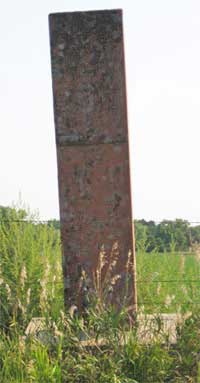
Click on Photos to
Expand |
|
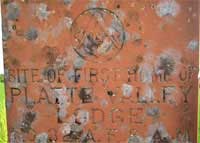 |
|
|
The Stone Monument at Cottonwood
Springs |
|
This
monument is located .5 miles from the intersection of Cottonwood
Springs Rd and E. Fort McPherson going east and .5 of a mile from a
90 degree turn on E. Fort McPherson Rd. going west. It is on the
south side of E. Fort McPherson Rd. and about .1 of a mile from the
marker designating the original site of Fort McPherson. It
designates the site of the George McDonald Store which is the birth
place of William H. McDonald , George’s son and the first white boy
born in Lincoln County and also the first home of Platte Valley
Lodge No. 32 AF & AM. The legal description of the property on
which it is erected is: East ½ of the North east Quarter of
Section 16, Township 12, Range 28 West according to Mr. Wade Burke
who is listed as the lease holder of this tract, this was verified
by talking to the Nebraska Educational Land Board in Lincoln
Nebraska on Sept. 1, 2009. This places the monument on Nebraska
School lease land. The Lincoln office advised me that there is no
written record of an easement or note made regarding it on the
property which means that there was maybe, at the time of erection,
some verbal agreement from the lease holder and Mr. McDonald. The
monument is red granite 8 feet high, 10 inches thick and 20 inches
wide imbedded in a concrete base which is 44 inches long and 33
inches wide and 20 inches, or better, deep and has 2 inscriptions on
the side facing the road. See pictures on this disc. The top
inscription reads: “Overland Ranch of Charles McDonald. Established
at Cottonwood Springs on Oregon trail, January, 1860. His son, Wm.
H. McDonald, was born here June 14, 1861, being the first white
child born in this county.” The Bottom Inscription reads: Site of
the first home of Platte Valley Lodge No. 32 A F & A M organized
November 15, A L 5869 U.D. January 15 AL 5870 Moved to North
Platte Sept. 10, AL 5872 This stone dedicated June 14, AL 5931.”
It should be noted that the World Herald article left out a part of
the bottom inscription.
There is an article and picture in the June 21 edition of The Omaha
World Herald showing the stone and 6 people standing by it, one is
William McDonald’s oldest daughter who unveiled it, as according to
the article Bro. McDonald was in Europe at the time. Only one man is
visibly clothed with a Masonic Apron and that appears to be Bro.
Charles Hendy.
|
|
|
Cottonwood Springs / Fort McPherson |
|
Fort McPherson was originally called Cantonment McKean,
and was popularly known as Fort Cottonwood. The Fort was
an Indian Wars-era U.S. Army installation in Nebraska
Territory located near the site of present-day North
Platte, Nebraska.
Fort McPherson was located on the banks of the North
Platte River, at the mouth of Cottonwood Canyon, a
strategic location near the junction of South and North
Platte Rivers. Cottonwood Springs, a natural spring in
an abandoned bed of the river, was the only spring for
many miles along the river and a favored spot used by
the plains Indians. |
|
|
|
A man by the name of Charles MacDonald had built a cedar
ranch at the mouth of Cottonwood Canyon, which canyon came
down to the river near Cottonwood Springs. Cottonwood
Springs was merely a seep in a gully which had been an old
bed of the river, and which had curved up towards Cottonwood
Canyon. The water-bed of the river being largely composed of
gravel, the water came down in the underflow, and seeped out
at a place down in the bank where there had grown a large
cottonwood tree. This spring had been dug out, and was the
only spring as far as known along the Platte for two hundred
miles. It was at the mouth of Cottonwood Canyon that we were
to build our military post. The place was a great crossing
for the Indians going north and south. The valley here was
several miles wide. There was a large island in the river of
several thousand acres, upon which grew the finest grass to
be found in the country, and there were some scrubby willows
and cottonwoods; so that the Indians coming from the north
found it a good stopping-place to feed their ponies either
in summer or winter, because in the winter the ponies could
eat the cottonwood brush. In addition to this, Cottonwood
Canyon gave a fine passage to the south. A road went up on
the floor of the canyon, between the trees, until it rose
onto the tableland twenty miles south. The canyon furnished
fuel and protection. It was for the purpose of breaking up
this Indian run-way that we were ordered to build a post at
the mouth of the canyon |
|
|
|
|
|
 |
|

